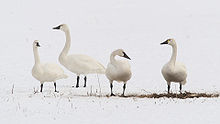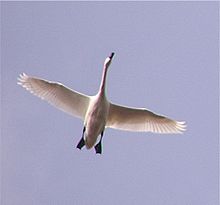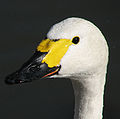Tundra Swan
| Tundra Swan (Bewick's Swan/Whistling Swan) | |
|---|---|
 | |
| Adult Bewick's Swan, Cygnus columbianus bewickii | |
| Conservation status | |
| Scientific classification | |
| Kingdom: | Animalia |
| Phylum: | Chordata |
| Class: | Aves |
| Superorder: | Galloanserae |
| Order: | Anseriformes |
| Family: | Anatidae |
| Subfamily: | Anserinae |
| Tribe: | Cygnini |
| Genus: | Cygnus |
| Species: | C. columbianus |
| Binomial name | |
| Cygnus columbianus (Ord, 1815) | |
| Subspecies | |
C. c. bewickii (Yarrell, 1830), Bewick's Swan
C. c. columbianus (Ord, 1815), Whistling Swan | |
| Synonyms | |
Anas columbianus Ord, 1815
Cygnus bewickii (Yarrell, 1838) Cygnus bewickii jankowski (lapsus) Cygnus bewickii jankowskii Cygnus columbianus jancowskii (lapsus) Cygnus columbianus jankowskii Olor bewickii (Yarrell, 1838) Olor columbianus (Ord, 1815) | |
The Tundra Swan (Cygnus columbianus) is a small Holarctic swan. The two taxa within it are usually regarded as conspecific, but are also sometimes split into two species, Cygnus bewickii (Bewick's Swan) of the Palaearctic and the Whistling Swan, C. columbianus proper, of the Nearctic. Birds from eastern Russia (roughly east of the Taimyr Peninsula) are sometimes separated as the subspecies C. c. jankowskii, but this is not widely accepted as distinct, most authors including them in C. c. bewickii. Tundra Swans are sometimes separated in the genus Olor together with the other Arctic swan species.
Bewick's Swan is named after the engraver Thomas Bewick, who specialised in illustrations of birds and animals.
Description
C. columbianus is the smallest of the Holarctic swans, at 115–150 cm (45–59 in) in length, 168–211 cm (66–83 in) in wingspan and a weight range of 3.4–9.6 kg (7.5–21 lb). In adult birds, the plumage of both subspecies is entirely white, with black feet, and a bill that is mostly black, with a thin salmon-pink streak running along the mouthline and – depending on the subspecies – more or less yellow in the proximal part. The iris is dark brown. In birds living in waters that contains large amounts of iron ions (e.g. bog lakes), the head and neck plumage acquires a golden or rusty hue. Pens (females) are slightly smaller than cobs (males), but do not differ in appearance otherwise.
Immatures of both subspecies are white mixed with some dull grey feathering, mainly on the head and upper neck, which are often entirely light grey; their first-summer plumage is quite white already, and in their second winter they moult into the adult plumage. Their bills are black with a large dirty-pink patch taking up most of the proximal half and often black nostrils, and their feet are dark grey with a pinkish hue. Downy young are silvery grey above and white below.
Bewick's Swans are the smaller subspecies. There is a slight size cline, with the eastern birds being slightly larger; good measurement data only exists for the western populations however. These weigh 3.4–7.8 kg (7.5–17 lb), 6.4 kilograms (14 lb) on average in males and 5.7 kilograms (13 lb) in females. They measure 115–140 cm (45–55 in) in overall length; each wing is 46.9–54.8 cm (18.5–21.6 in) long, on average 51.9 centimetres (20.4 in) in males and 50.4 centimetres (19.8 in) in females. The tarsus measures 9.2–11.6 cm (3.6–4.6 in) in length, the bill 8.2–10.2 cm (3.2–4.0 in), averaging 9.1 centimetres (3.6 in). Bewick's Swan is similar in appearance to the parapatric Whooper Swan (C. cygnus), but is smaller, shorter-necked and has a more rounded head shape, with variable bill pattern, but always showing more black than yellow and having a blunt forward edge of the yellow base patch. Whooper Swans have a bill that has more yellow than black and the forward edge of the yellow patch is usually pointed. The bill pattern for every individual Bewick's Swan is unique, and scientists often make detailed drawings of each bill and assign names to the swans to assist with studying these birds. The eastern birds, apart from being larger, tend towards less yellow on the bill, perhaps indicating that gene flow across Beringia, while marginal, never entirely ceased. An apparent case of hybridization between a Bewick's and a vagrant Whistling Swan has been reported from eastern Siberia.
Whistling Swans weigh 9.5–21 lb (4.3–9.5 kg) – 16 pounds (7.3 kg) on average in males and 14 pounds (6.4 kg) in females –, and measure 47–59 in (120–150 cm) in length. Each wing is 19.7–22.4 in (50–57 cm) long; the tarsus measures 3.7–4.5 in (9.4–11 cm) in length, and the bill is 3.6–4.2 in (9.1–11 cm) long. C. c. columbianus is distinguished from C. c. bewickii by its larger size and the mostly black bill, with just a small and usually hard to see yellow spot of variable size at the base. It is distinguished from the largely allopatricTrumpeter Swan (C. buccinator) of North America by that species' much larger size and particularly long bill, which is black all over except for the pink mouthline, which is stronger than in the Whistling Swan.
Note that color variations with more or less yellow, or pink instead of yellow or black, are not exceptional, especially in Bewick's Swans, which very rarely may even have yellowish feet. The small size and particularly the rather short neck, which make it look like a large white goose, are still distinguishing marks.
Tundra Swans have high-pitched honking calls and sound similar to a black goose (Branta). They are particularly vocal when foraging in flocks on their wintering grounds; any conspecific arriving or leaving will elicit a bout of loud excited calling from its fellows. Contrary to its common name, the ground calls of the Whistling Swan are not a whistle and neither notably different from that of Bewick's Swan. The flight call of the latter is a low and soft ringing bark, bow-wow...; the Whistling Swan gives a markedly high-pitched trisyllabic bark like wow-wow-wow in flight. By contrast, the Whooper and Trumpeter Swans' names accurately describe their calls – a deep hooting and a higher-pitched French horn-like honk, respectively. Flying birds of these species are shorter-necked and have a quicker wingbeat than their relatives, but they are often impossible to tell apart except by their calls.








No comments:
Post a Comment